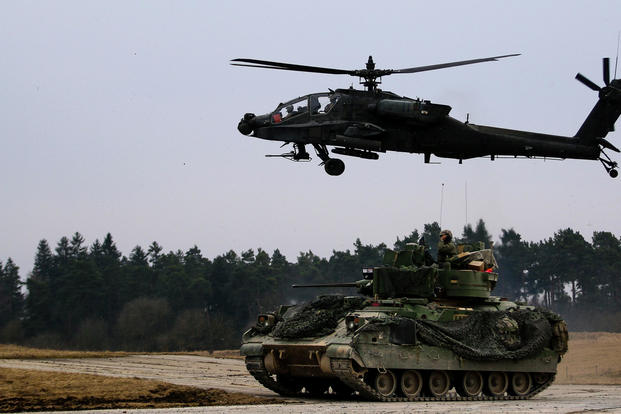1. ARMY’S BIG TECHNOLOGY GAMBLE
From Military.com’s Matthew Cox:
"The U.S. Army is locked on a path to replace its tanks, helicopters and other major combat systems -- a daunting venture in itself. But the true challenge for the service may be avoiding the minefield of mistakes that led to the multibillion-dollar demise of another leap-ahead plan, Future Combat Systems, less than a decade ago.
As with FCS, the Army is gambling big on advanced technologies, including some that don't exist yet in an operational form. It's a strategy that service leaders believe will place the Army ahead of its global competitors.
But military modernization experts watching the effort unfold warn that the service must guard against program flaws that have poisoned past dreams of a future force: poor salesmanship, weak leaders, priorities that shift over time, and the Army's true Achilles heel -- the enticement of leap-ahead technology.
… [Army Secretary Mark] Esper and many other Army leaders spent the entire three days of the AUSA winter meeting [in late March] explaining in detail how the service would create its force of the future. Teams of specialists from across the Army will work together like never before to cut years off the process of developing, selecting, testing and fielding advanced combat systems, officials said.
That's if all goes as planned."
2. COULD KOREAN PEACE TALKS LEAD TO TROOP WITHDRAWAL?
From Military.com’s Richard Sisk:
U.S. troop withdrawal could be up for negotiation if North Korea and South Korea can solidify a lasting peace deal, Defense Secretary Jim Mattis said Friday.
Mattis was cautious in his response to a question on the potential for withdrawals following the historic meeting Friday of the leaders of North and South Korea.
'That's part of the issues that we'll be discussing in negotiations with our allies first, and of course with North Korea,’ he said.
He made no predictions on the status of the 28,000 U.S. troops now stationed in South Korea.
The prospect that a U.S. Secretary of Defense would have entertained even the vaguest thought of troop withdrawal from the peninsula would have been unthinkable only a few weeks ago, but North Korean leader Kim Jong-un's attempted transformation from dictator and nuclear bully to potential peace partner has altered the diplomatic and military equation.
3. CALIFORNIA GUARD TROOPS HEAD TO BORDER
"The National Guard is heading to the California-Mexico border this week in what marks the first deployment under Gov. Jerry Brown's deal with the Trump administration to beef up border security.
About 200 Guard members were expected to arrive at Camp Roberts in Central California on Saturday for training before deploying to El Centro and San Diego in the middle of next week, Lt. Col. Thomas W. Keegan said in a statement.
Guard members will not enforce immigration laws, nor will they help construct a border wall during the deployment, which will run through September. Brown and federal officials agreed to those terms this month after Trump requested that the nation's border governors increase security along the border.
… About 55 Guard members are already helping to fight illegal drug trafficking, manufacturing and distribution along the border in California."
4. F-16 COLLISION RULED PILOT ERROR
"Two F-16C Fighting Falcons collided head-on in a June 7, 2016, incident because one of the pilots failed to properly deconflict flight paths, the Air Force said Friday.
The crash took place at the Bulldog Military Operation Area close to Louisville, Georgia, and involved pilots assigned to two units: the 316th Fighter Squadron, 169th Fighter Wing; and the 157th Fighter Squadron, 169th Fighter Wing, both out of McEntire Joint National Guard Base, South Carolina.
Both pilots ejected and survived with minor injuries; the aircraft were destroyed, totaling a $60.8 million loss.
In November 2016, CBS news affiliate WRDW reported that debris was still being recovered, months after the crash. According to the Air Force release, it cost $90,000 to complete environmental cleanup from the crash."
5. PENTAGON OVERPAID MILLIONS FOR BREAST PUMPS
From Richard Sisk and Amy Bushatz:
"The Pentagon has been spending as much as $1,400 for an electric breast pump that goes for $192 in stores, according to an Inspector General's report released Friday.
Overall, the Defense Health Agency (DHA) overpaid $16.2 million for standard electric breast pumps and replacement parts provided to beneficiaries in the former North, South and West Tricare regions, the Pentagon IG's office said.
DHA 'overpaid for breast pumps by 91.2 percent [overpaying for 54,006 of 59,241 pumps] and by 56.8 percent for replacement parts [overpaying for 380,911 of 671,112 parts] when compared to the negotiated fixed reimbursement rate for eight different breast pump models,' the report said … The worst example of overpayment was to a supplier in Pennsylvania in Tricare's then-North region of $1,400 for a ‘Medela Pump in Style Starter Set.'
'This same breast pump can also be purchased on the open market for $192,' the IG's report said."
-- Hope Hodge Seck can be reached at hope.seck@military.com. Follow her on Twitter at @HopeSeck.














